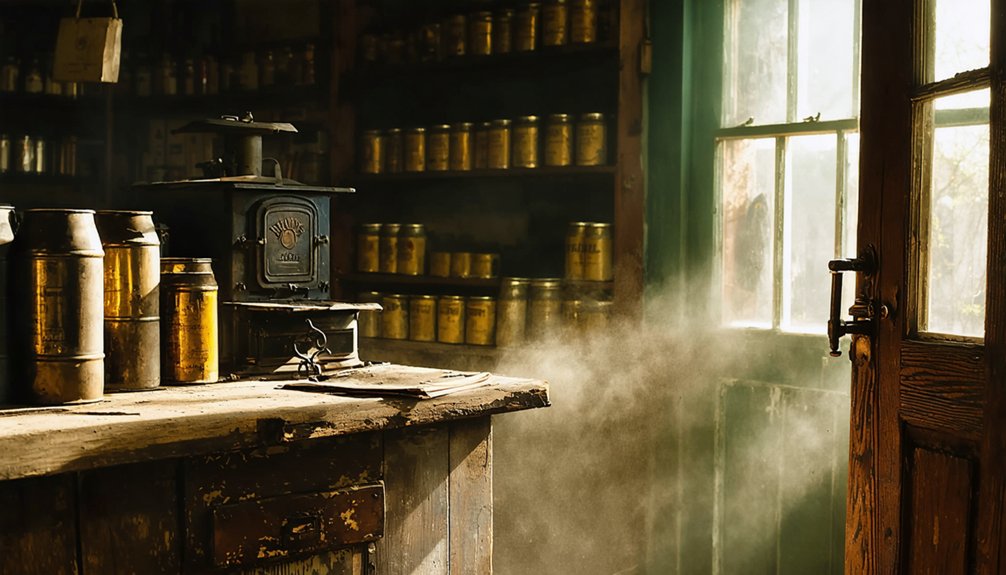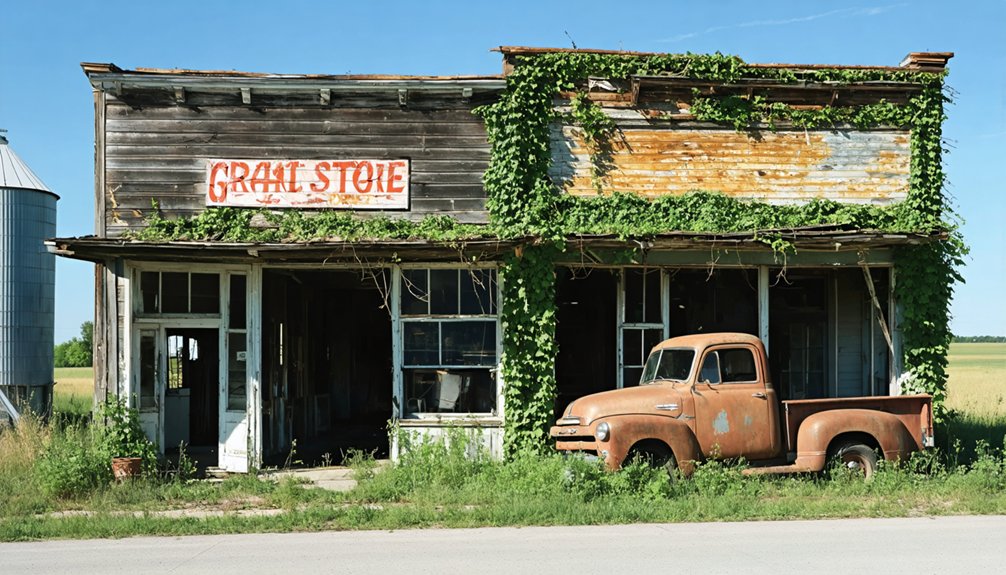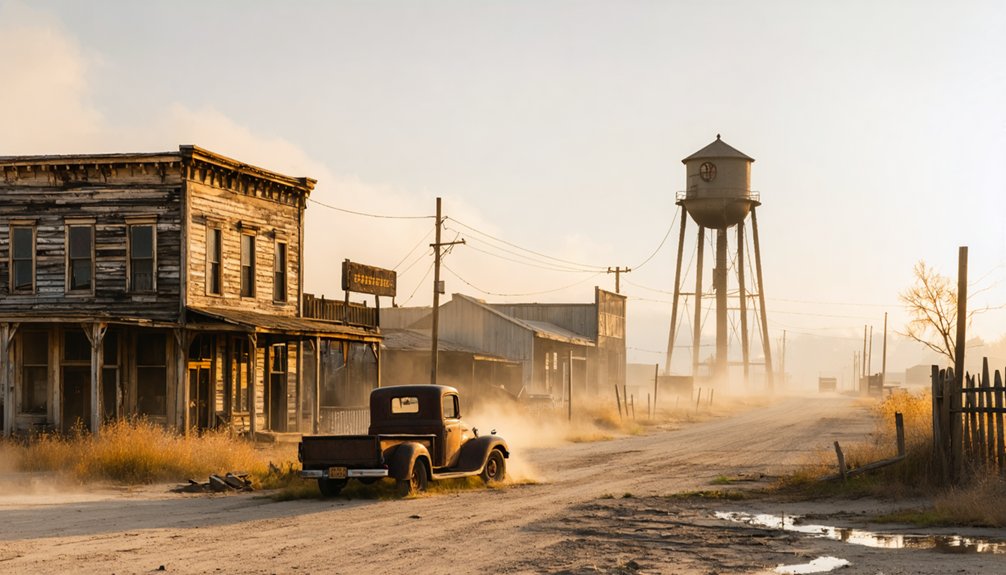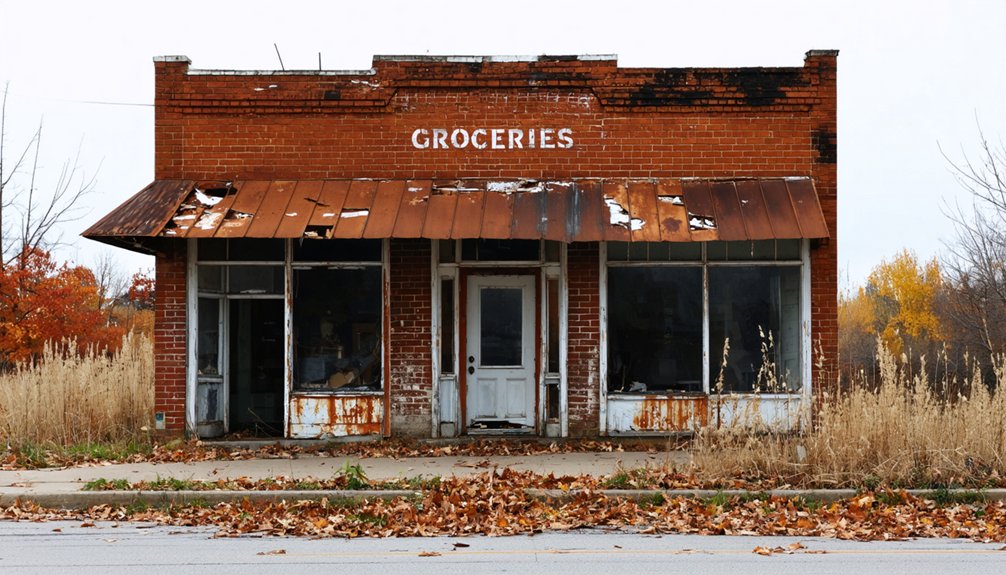You’ll find the lost settlement of Crabtown along the Maquoketa River in eastern Iowa, where the pioneering Crab family established their homestead in the mid-1800s. Today, only foundations and artifacts remain of this once-thriving community that featured sawmills and wool-carding facilities. While the original buildings are gone, you can still explore the historic river bridge, settlers’ cemetery, and archaeological remnants via Highway 61 and Caves Road. The site’s rich history holds countless untold stories of frontier life.
Key Takeaways
- Crabtown was established by the Crab family in mid-1800s Iowa along the Maquoketa River, thriving initially due to fertile soil and natural resources.
- The settlement featured sawmills, wool-carding facilities, and agricultural infrastructure before its eventual abandonment and ghost town status.
- Economic decline, transportation changes, and reduced government support led to Crabtown’s transformation from active settlement to abandoned ghost town.
- Visitors can explore Crabtown’s remains via Highway 61 and Caves Road, with the historic river bridge marking the former settlement’s center.
- Archaeological evidence includes metal tools, building foundations, and household items from the 1800s-1900s, reflecting the town’s rural pioneer life.
Early Settlers and Town Origins
The story of Crabtown, Iowa begins with the ambitious Crab family, whose influence shaped this mid-19th century frontier settlement in Jackson County.
Like many settlers who ventured west after the Black Hawk Purchase of 1833, they were drawn by the promise of fertile soil and abundant natural resources.
You’ll find that settler motivations aligned perfectly with the region’s offerings – rich farmland for early agriculture, flowing rivers for trade, and ample timber for building.
The town’s first residents, including traders and farmers from eastern states like New York and Indiana, established themselves through a mix of temporary visits that evolved into permanent homesteads.
They built relationships with local Native American tribes while developing essential infrastructure like sawmills and wool-carding facilities, laying the foundation for what would become a thriving frontier community. The settlers followed similar patterns to those like Dr. Samuel Muir, who formed strong connections through marriages to Indian women while establishing their presence in the territory. The area had been under loose political control by European powers before becoming firmly American territory.
Life Along the Maquoketa River
Meandering through northeastern Iowa’s Driftless Area, Maquoketa River shaped daily life in Crabtown with its pristine waters and abundant resources. Early settlers like J.E. Goodenow and Lyman Bates were drawn to establish homes along its banks in 1838. The area became a popular rest stop post for pioneers heading westward.
You’d find thriving river ecosystems teeming with smallmouth bass and trout, while limestone cliffs towered above the ancient forests and rocks below. The river’s name, meaning “Bear River,” echoed the heritage of Winnebago, Sac, and Fox tribes who once called these shores home.
Living along the Maquoketa meant you’d enjoy:
- Prime fishing opportunities in the 150-mile waterway
- Fertile soil perfect for growing crops
- Limestone quarries providing building materials
- Natural beauty that drew visitors from miles around
The river’s pristine waters sustained both the town’s economy and its spirit, offering freedom to those who sought life along its banks.
Finding the Lost Settlement Today
You’ll find Crabtown’s vanished location by following Highway 61 to Caves Road, then taking 150th Street east until you reach the bridge crossing the Maquoketa River.
The old bridge marks what was once the heart of this riverside settlement, though no buildings remain to tell its story. The town was named after the pioneering Crab family who first settled here. Located in Jackson County, this historic site links to several nearby communities.
For the best access and visibility, plan your visit during dry weather in late fall or early spring when vegetation is minimal and the river runs clear.
Modern Landmarks Guide
Located near the Maquoketa River in Jackson County, Iowa, Crabtown’s remnants await discovery just east of a prominent bridge crossing.
Today’s adventurers exploring this ghost town’s history can use modern tools like GPS to navigate to the site by following Highway 61 north of Maquoketa, then turning onto Caves Road.
The area was once home to the Crab Family settlers who gave the town its distinctive name in the mid-1800s.
Similar to many Iowa settlements that were spaced every five miles apart, Crabtown eventually succumbed to changing times.
To explore Crabtown’s preserved legacy, look for these key landmarks:
- The historic river bridge marking the settlement’s location
- A cemetery containing graves of original settlers, including the Crab family
- Several deteriorating building foundations scattered across the area
- Surrounding artifacts that metal detector enthusiasts occasionally uncover
Though no official visitor center exists, the site’s accessibility via 2-wheel-drive roads makes it an ideal summer destination for those seeking to connect with Iowa’s rural heritage.
Reaching The River Bridge
Though finding the lost settlement of Crabtown requires careful navigation, reaching the historic site starts with a straightforward drive north from Maquoketa on Highway 61.
You’ll turn onto Caves Road and continue about a mile past the caves, then follow 150th Street until you reach the Maquoketa River.
While historical mapping shows the original Caven Bridge once crossed here, that iron structure’s now gone.
Today, your best river navigation point is the Crab Town Bridge on Highway Y31 (Bernard Road).
The bridge area offers excellent views of the jade green river, making it a scenic spot for photography and wildlife watching. The location serves as an alternate take-out point for paddlers exploring the North Fork Maquoketa River.
You can park on the upstream north side, but watch for uneven ground and loose rocks.
If you’re planning to explore the southern bank where the settlement once stood, you’ll need landowner permission – the original townsite lies on private property just east of the bridge.
Seasonal Visiting Tips
Once you’ve pinpointed the bridge location, timing your visit to Crabtown becomes the next key consideration.
Summer stands out as your prime window for seasonal activities, offering ideal conditions with warm weather and extended daylight hours for exploration.
For maximum visitor preparedness, keep these essential factors in mind:
- Plan your visit during summer months when trails are clear and artifact visibility is at its best
- Pack plenty of water, sun protection, and sturdy boots for riverbank exploration
- Download offline maps before heading out, as cell service can be spotty
- Bring metal detecting equipment if you’re interested in searching for historical remnants
Daily Pioneer Life and Community

You’d find life in Crabtown centered around daily agricultural tasks and the constant challenge of maintaining a homestead along the Maquoketa River’s banks.
In this close-knit settlement, families would gather for shared meals, barn-raisings, and cemetery memorials – creating bonds that helped them weather Iowa’s harsh summers and bitter winters.
The river provided both sustenance and social connection, as settlers fished its waters and used the bridge as a meeting point for community activities.
Daily Frontier Hardships
While settlers dreamed of prosperity in Crabtown, Iowa, they’d soon face grueling daily challenges that tested their resilience.
You’d battle harsh winters in basic wooden shelters, relying on fireplaces and community support just to survive. Economic isolation and limited transportation made accessing supplies nearly impossible, especially during adverse weather.
Living on the frontier meant confronting:
- Resource scarcity – gathering water daily, sourcing local materials, and preserving food
- Health risks – treating illnesses with home remedies while medical help remained distant
- Agricultural struggles – clearing difficult terrain and dealing with seasonal crop uncertainties
- Manual labor demands – maintaining homes, repairing tools, and tending to livestock
When conditions became unbearable, you’d consider seasonal migration, following work opportunities or escaping extreme weather – a reflection of the resourcefulness needed for frontier survival.
Despite their daily hardships, Crabtown’s pioneers found strength and purpose through vibrant community activities that wove the social fabric of frontier life.
You’d have witnessed neighbors gathering for barn raisings and corn husking bees, where work merged seamlessly with socializing. The local church anchored the community through Sunday services, seasonal celebrations, and religious education.
Community gatherings centered around the trading hub, where you could barter farm goods, visit the blacksmith, or exchange news at the post office. Social events ranged from literary societies and public meetings to festive dances and county fairs.
At the one-room schoolhouse, spelling bees and holiday programs brought families together, while children learned both academic basics and practical trades through apprenticeships with local craftsmen.
The Bridge: Last Standing Witness
Standing as a silent sentinel to history, the bridge at Crabtown remains the last physical remnant of this vanished Iowa settlement.
This late 19th-century structure‘s architectural significance reflects the engineering common to rural Iowa’s covered bridges, though time and elements have left their mark.
You’ll discover the bridge’s enduring legacy through:
- Its status as the final witness to Crabtown’s existence, named after the pioneering Crab family
- Easy access via Highway 61 and Caves Road, perfect for modern-day explorers
- Rich bridge folklore that mirrors other haunted Iowa bridges like Roseman
- Potential for artifact hunting in the surrounding area with metal detectors
The bridge beckons you to step back in time, offering a tangible connection to Iowa’s rural past and the freedom of the open frontier.
Why Towns Like Crabtown Disappear

Much like countless other American ghost towns, Crabtown’s descent into abandonment mirrors a familiar pattern of decline that you’ll find across rural Iowa.
You’ll recognize the telltale signs: economic decline as primary industries fade away, leaving workers with no choice but to seek opportunities elsewhere. Transportation shifts bypassed the town’s once-vital trading routes, while demographic changes saw younger residents drawn to bigger cities for better prospects.
Environmental factors played their part too – the region’s changing agricultural conditions made it harder for local farmers to sustain their operations.
When you combine these challenges with political causes, including reduced government support for rural communities, you’ll understand why towns like Crabtown couldn’t survive.
It’s a story that’s repeated itself throughout America’s heartland, where tomorrow’s promises often meant yesterday’s towns would fade away.
Hidden Treasures Beneath the Earth
While time has erased Crabtown’s surface structures, the earth beneath holds a treasure trove of historical artifacts that tell the story of this lost Iowa settlement.
Thanks to natural sedimentation and the Maquoketa River’s periodic flooding, artifact preservation remains remarkably intact.
You’ll discover evidence of daily life through:
- Metal fragments and tools dating from the mid-1800s to early 1900s
- Building foundations and bridge remnants that reveal the town’s layout
- Wells and drainage ditches showing agricultural infrastructure
- Iron nails, bolts, and household items reflecting rural family life
Modern archaeological techniques like metal detecting and ground-penetrating radar let you explore these hidden treasures without disturbing protected zones.
While you won’t find gold or precious gems, the real value lies in uncovering the authentic story of Iowa’s frontier settlers.
Legacy of a Frontier Settlement

Beyond the buried artifacts and relics lies a deeper story of Crabtown’s influence on Iowa’s frontier development.
You’ll find echoes of pioneer heritage in the town’s brief but significant existence, from its humble beginnings as a single cabin in 1847 to its role in shaping early rural governance. The settlement patterns of Crabtown mirror countless other frontier communities that dotted Iowa’s landscape during territorial expansion.
While you won’t find buildings standing today, Crabtown’s legacy lives on through family histories and local chronicles.
The town’s decline reflects a broader American story of adaptation and change, particularly as railroad routes determined which settlements would thrive.
Even now, the old bridge over the Maquoketa River stands as a silent witness to this chapter of Iowa’s pioneering spirit.
Frequently Asked Questions
Were Any Famous Outlaws or Notable Historical Figures Connected to Crabtown?
You won’t find any outlaw history or notable residents connected to this place – historical records show it was simply a small settlement named after the Crab family who first settled there.
Did Native American Tribes Have Settlements Near Crabtown Before Pioneers Arrived?
For thousands of incredible years, you’ll find Native American settlements flourished near these riverlands. The Oneota, Sauk, and Meskwaki tribes called this fertile region home before pioneers pushed them westward.
What Natural Disasters or Extreme Weather Events Affected Crabtown?
You won’t find specific records of flooding events or tornado history for this location, though its proximity to the Maquoketa River suggests it likely faced seasonal floods like other river towns.
Are There Any Known Photographs or Drawings of Crabtown?
You won’t find much visual evidence of this place, as historical documentation is quite limited. While local archives might hold some photographs, they’re not readily available for public viewing.
Did Crabtown Have a Cemetery, and if So, Where Was It?
As luck would have it, you’ll find Crabb Cemetery standing near the Maquoketa River, marking local burial customs. It’s one of the few remaining traces of the settlement’s past you can still visit.
References
- https://www.youtube.com/watch?v=n8j-s9rJ1NQ
- https://www.discoverguthriecounty.org/ghosttowns
- https://www.youtube.com/watch?v=L883pwCPOwE
- https://www.ghosttowns.com/states/ia/crabtown.html
- https://pubs.lib.uiowa.edu/annals-of-iowa/article/id/6960/download/pdf/
- https://en.wikipedia.org/wiki/List_of_ghost_towns_in_Iowa
- https://www.onlyinyourstate.com/trip-ideas/iowa/ia-ghost-towns
- https://en.wikisource.org/wiki/History_of_Iowa_From_the_Earliest_Times_to_the_Beginning_of_the_Twentieth_Century/1/13
- https://history.iowa.gov/media/539/download?inline
- https://en.wikipedia.org/wiki/History_of_Iowa



